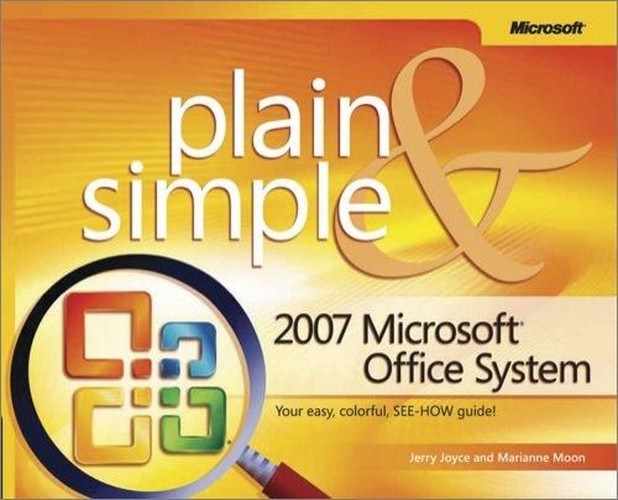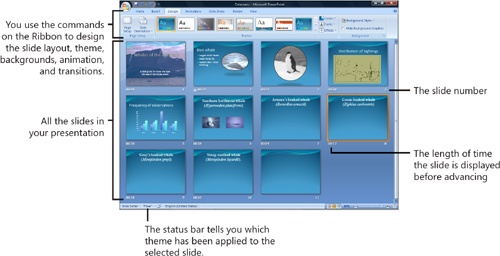In this section:
When you attend a company meeting, a talk, a school presentation, a sales pitch, or just about any other type of gathering where information is being presented, it’s a sure bet that you’ll see at least one slide presentation. Microsoft Office PowerPoint 2007 has made creating slide presentations so simple that we almost don’t need to write about it—but we will anyway, because PowerPoint has so many great features that we want you to know about.
As with most Office programs, you can use one of PowerPoint’s existing layouts, or you can create your own slide presentation from scratch. You can choose a theme to create a unified design throughout all the slides in your presentation; modify a theme; or design your own customized theme, choosing the background, the colors, and the fonts to complement the mood of the presentation. You can add tables and SmartArt graphics to your slides, and make them sparkle with some WordArt or animation. You can add a video, a sound clip, or some CD music to your presentation, and apply some of PowerPoint’s stunning transitions between clips to enhance your show with that extra touch of professionalism. And if you need to do a bit of editing and tweaking, you’ll find PowerPoint’s Outline view and Slide Sorter extremely simple to use and very helpful.
Microsoft Office PowerPoint 2007 is designed to create slide presentations. A presentation can have several components—the main one, of course, being the slides that display your pictures, text, charts, videos, and so on. PowerPoint can help you create the other components: handouts that include printed versions of your slides with accompanying text, and a script—that is, printed notes to assist you with your presentation. You’ll spend most of your time, however, working with the slides—modifying them to achieve the consistent look that results in a polished presentation, and rearranging them so that they’re shown in the most logical order. You create the individual slides in Normal view (shown below), adding text and graphics to content boxes (which are just plain text boxes ready to receive text or other content), tweaking the color scheme, and adding new slides.
You use Slide Sorter view (shown below) to organize your entire presentation and to make sure that all the design elements have a consistent look. You can also use Slide Sorter view as a kind of "storyboard" for reviewing your presentation: Just double-click a slide in Slide Sorter view, and the slide will open in Normal view, ready for editing. Slide Sorter view is also the view to use when you’re setting up your slide show’s properties—for example, the animation scheme, if you’re using one for your slides, and/or the transition effects as one slide advances to the next.
There are other views—Slide Show view and Notes Page view, as well as the view of the Slide Master, the Handout Master, and the Notes Master—that we haven’t shown here. Slide Show view is self-explanatory and Notes Page view is similar to Normal view except that it’s formatted as a printed page; it shows a printed version of the slide and includes an area where you can type your notes. The three Master views allow you to set up the overall layout and look of your slides, handouts, and notes.


